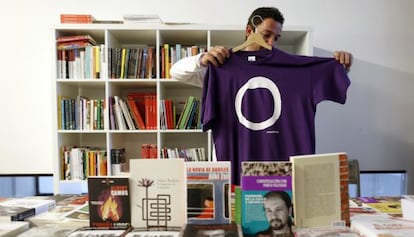Would you wear a t-shirt promoting your political party of choice?
The net is the new battleground, but old campaigning methods are still working for some


Posters of Spain’s general election candidates went up across the country last week, marking the official start of campaigning for the December 20 vote.
But the truth is, the practice is looking increasingly dated, and parties are starting to use them less and less.
“We have worked for several parties with posters and brochures, but for the last five or six years our sales volume has declined significantly; they order fewer every time,” confirms a worker at one Madrid printing firm.
Posters are an old campaigning method with modest effects, but if someone puts one up, then you put one up too, because you don’t want to be at a disadvantage”
Lluis Orriols, political scientist
Neither the Popular Party (PP) nor the Socialist Party (PSOE) would provide any figures on how much they spend on printed material. But it seems clear that the rise of online communications, especially social media, has created a cheaper and more efficient way to deliver political messages.
New parties such as Podemos and Ciudadanos owe a lot of their support to these new forms of communication, and traditional organizations are joining in.
But here is where a paradox emerges: while the old-school PP and PSOE are increasingly embracing the internet, newcomer Podemos is the only party that actually has stores selling typical merchandising products such as t-shirts, bracelets and lapel pins.

“I doubt anyone would wear a PP or PSOE t-shirt,” says Jorge Lago, a Podemos official who looks after La Morada, an establishment run by the party in southern Madrid that features a bar and a store. “That’s why they don’t make them. If you spend money on merchandising, it’s in order to sell it. And if you feel embarrassed about it, you’re not going to put on the t-shirt.”
The store sells books and magazines, but also Podemos tees for €9, bags for €7, pins for €1 and bracelets for €2.50. The bracelet is its bestselling item.
“We are a new party and the tees, the logos, the objects, all create a sense of community and something to identify with,” adds Lago. “This makes our voters human, it makes them normal. Other people see that our voters don’t have horns and a tail.”
The PSOE did not respond to EL PAÍS’s queries on the subject. Meanwhile, PP deputy chief of communications Pablo Casado said that ”these are the elections in which social media are playing the most important role.” The PP’s initiatives include a series of videos, some of which fall under the slogan Piensa sin prejuicios (Think without prejudice) and aim to refute “preconceived notions” about the government.
Casado confirms that posters and brochures now represent “a residual expense” on the PP’s campaign budget. But he says that posters still work, especially in provincial areas. “I was shown a very pretty brochure, but I said no because it was expensive,” he explains. “Besides the fact that people think that this is not the right time to be splashing out, I actually prefer to print 50 posters than 100 brochures. People want to see the candidate’s face.”
But Podemos – whose leader Pablo Iglesias has 1.3 million followers on Twitter – is scornful about the traditional parties’ efforts to reach out online.
“The vertical campaign comprising an active transmitter and a passive receptor no longer works,” says Lago. “With the social media, voters participate and discuss issues. The PP and the PSOE send messages, but they don’t reply and they don’t debate, and when the campaign is over they stop using Twitter.”
This is the first general election with two clear battlegrounds: the analog and the digital. Often, the target audience is different in each one.
The PP and PSOE conceal their brands because they create a rejection even among their own voters” Ciudadanos official Fernando de Páramo
“They are two different worlds, and there is a generational gap,” explains Lluis Orriols, a political scientist at Madrid’s Carlos III University. “Posters are an old campaigning method with modest effects, but if someone puts one up, then you put one up too, because you don’t want to be at a disadvantage. All factors have an effect, even mail campaigns, no matter how small. This effect has been studied.”
Ciudadanos, for instance, feels at home on both battlefields. Fernando de Páramo, the party’s communications guru, notices that the party’s name generates a certain amount of pride online. “The PP and PSOE conceal their brands because they create a rejection even among their own voters,” he says. “But not so with ours. Social media users do not feel that our brand is going to hurt them. They share it, send images and comments, it gets mixed together with photos and messages from family and friends. Being present there is both difficult and very important.”
De Páramo says lapel pins and other merchandising items play a minor role for Ciudadanos, but that brochures are an important part of the battle on the streets. In this, as in other things, Ciudadanos takes the middle ground: it shies away from huge billboards but plasters bus stops and train stations with posters of party leader Albert Rivera, a brand unto himself.
English version by Susana Urra.
Tu suscripción se está usando en otro dispositivo
¿Quieres añadir otro usuario a tu suscripción?
Si continúas leyendo en este dispositivo, no se podrá leer en el otro.
FlechaTu suscripción se está usando en otro dispositivo y solo puedes acceder a EL PAÍS desde un dispositivo a la vez.
Si quieres compartir tu cuenta, cambia tu suscripción a la modalidad Premium, así podrás añadir otro usuario. Cada uno accederá con su propia cuenta de email, lo que os permitirá personalizar vuestra experiencia en EL PAÍS.
En el caso de no saber quién está usando tu cuenta, te recomendamos cambiar tu contraseña aquí.
Si decides continuar compartiendo tu cuenta, este mensaje se mostrará en tu dispositivo y en el de la otra persona que está usando tu cuenta de forma indefinida, afectando a tu experiencia de lectura. Puedes consultar aquí los términos y condiciones de la suscripción digital.








































